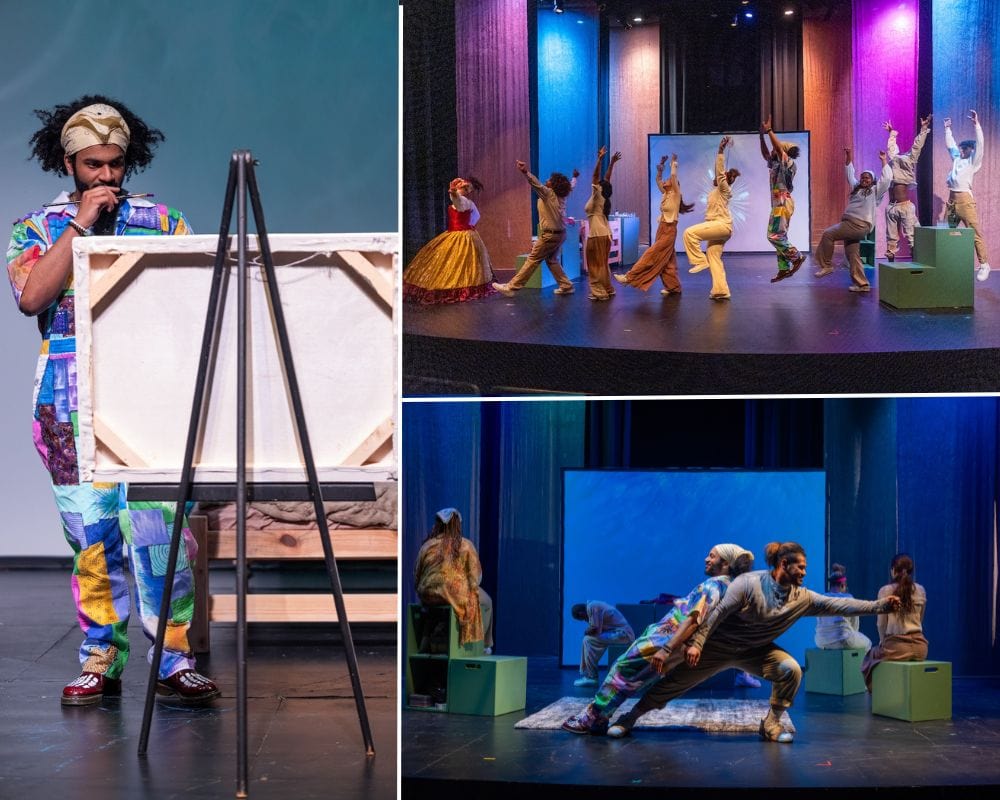In the DC–Maryland–Northern Virginia region, theater lovers have a surfeit of options to observe raw talent develop at stages in the region’s university and college performing arts departments. One recent example: the world-premiere play with dance When Two Hands Meet, written and directed by Georgetown University senior Shakeer Hood.
New Jersey–raised Hood studies theater performance and African-American studies at the private District university. Under the guidance of playwright, director, and Georgetown professor Natsu Onoda Power, Hood dove head first into writing, directing, and even performing in an original two-act play that centers African-American voices and personal and historic stories while emphasizing embodied Black joy.

The play follows Sugar, a young painter struggling with artist’s block, depression, and the recent death of his mostly absent father. Isaiah Hodges’ Sugar sports an artsy multicolored patchwork jumpsuit and a laid-back inquisitiveness. He’s a seeker — striving to come to terms with the loss of his father, a breakup with his boyfriend, and his disconnection from his mother. Sugar is enlightened, though not revelatory. He doesn’t like to share, even withholding his feelings from his therapist (Julia Wang), who presses him, but not too hard, to talk about his dad, his boyfriend, or his artistic dry spell.
While his painter’s brush runs dry, his imagination wanders as abstract colors undulate on a screen in the backdrop. An almost throwaway line — “I wish I could control time” — becomes prescient when Sugar finds himself face to face with Brotha Time, a spiffily dressed Malik Clinton in a white vest embellished with gold. This shift to magical realism or fantasy sets Sugar on a journey across decades and centuries where he finds himself in a 19th-century southern U.S. ballroom, a 1990s disco, slave quarters in antebellum South, and an underground nightclub amid urban ballroom culture competitions of the LGBTQ community. At each stop on this time-traveling adventure, Sugar discovers more about himself and his ancestors, either historic or personal.
Interspersed among these time-traveling scenes, a vibrant chorus of dancers serves as an illustrative chorus, bringing energy, collegiality, and contemporary flavor to the various ballroom scenes — illuminating in a dream-like way Sugar’s innermost desires to connect to a community, to his father, to a father-like figure. Clad in loose-fitting beige-and-white slacks and tunic ensembles, the dancers contrast grounded earthy stances and steps with more seductive hip and pelvis thrusts that would be found in a cipher — a circle of hip-hop dancers.
Hood has filled his script with sharp, witty rejoinders, like Brotha Time’s remark “This isn’t a house, it’s a condo,” and audience-affirming aphorisms. In fact, the opening night predominantly student audience could be heard vocalizing in agreement with many of these apt one-liners, like “Our lives are like little ticks on the clock” or “What’s sex without love? Nothing.” Or

“You can’t fail therapy; it’s a journey” or “The strongest of us are also the most vulnerable.” Nods and uh-huhs could be heard throughout the theater.
He has also included two mid-20th-century African-American public intellectuals as characters — Audre Lorde and James Baldwin — each of whom offers a few power-filled statements aligned with their philosophies.
When Two Hands Meet is a capstone thesis for writer/director Hood. As a first play from a developing writer, there is much to admire — including sharp, witty moments of dialogue. Like many first efforts, When Two Hands Meet could use some cutting and tightening. The cast of 11 student performers, who both act and dance, should warm to their roles as the run goes on.
An added bonus for theatergoers is the lobby exhibit on District Go-Go icon Chuck Brown curated by Soyica Diggs Colbert and designed by Natsu Onoda Power and Caitlin Lawlor.
Running Time: Approximately one hour and 50 minutes with one 10-minute intermission.
When Two Hands Meet by Shakeer Hood plays through March 24, 2024, presented by Georgetown University, College of Arts & Sciences Department of Performing Arts at the Davis Performing Arts Center at Georgetown University, 37th and O Streets NW, Washington, DC 20007. Tickets (general admission, $10; students, free) are available at the venue or online.
View the Georgetown University, College of Arts & Sciences Department of Performing Arts 23-24 Season Brochure here.




